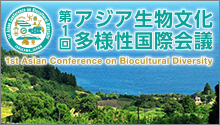On May 22, 2025, the International Symposium “Nature, Culture, and Community: Rethinking Urban Connections from Kanazawa” took place at the Kanazawa Bunka Hall. As cities around the world continue to grow and evolve, the interconnections between nature, culture, and community are increasingly central to shaping sustainable urban futures. This symposium brought together local and international experts, as well as city representatives, to explore innovative approaches to urban ecosystem regeneration while respecting and celebrating cultural heritage.
The event began with opening remarks from Takashi Murayama (Mayor of Kanazawa City).
Keynote speeches followed, featuring:
- Yulia Rubleva (Associate Programme Management Officer, Urban Nature, UNEP)
- Ingrid Coetzee (Director, Biodiversity, Nature & Health, ICLEI Africa
- Wataru Suzuki (Director, Biodiversity Strategy Office, MOEJ)
Rubleva presented on “Urban Nature for People and Planet: Restoring Ecosystems, Rebuilding Community”, and emphasized the growing recognition of nature’s critical role in building healthy, resilient cities. She stressed the importance of reconnecting cities with nature – not just for aesthetic value, but for their capacity to sustain life, foster culture and strengthen communities in this changing world.
Next, Coetzee presented on “Nature contributing to wellbeing, resilience, and connectivity in cities”, and showcased examples of urban initiatives that reflect strong links between ecological and human wellbeing, understanding the importance of partnerships and active community engagement.
Suzuki discussed “Cities for a society harmony with nature,” highlighting that Kanazawa has historically coexisted with nature. He emphasized that to restore biodiversity, it is necessary to simultaneously promote green conservation and restoration, climate change countermeasures, sustainable production, and consumption reduction. He also offered valuable insights connecting global, national, and local levels – from the implementation of the Post-2020 Global Biodiversity Framework (GBF), to Japan’s new national biodiversity strategy, and concrete applications of Nature-based Solutions at the local level.
The second half of the symposium featured a panel discussion moderated by Togo Uchida (Executive Director, ICLEI Japan), with contributions from:
- Dzheylan Safet Karaulan Sozuer (Architect & Urban Designer and Strategy Development & Program Coordinator, Istanbul, Türkiye)
- Anthony Paul Diaz (Superintendent/Director, Seattle Parks and Recreation, Seattle, USA)
- Francois Moreau (Head of Urban Ecology Agency, Paris, France)
- Kimberley Anne Statham (Director, Urban Forestry, Toronto, Canada)
- Laura Hernandez Rosas (Coordinator of Biodiversity Strategies, Mexico City, Mexico)
- Judith A. Oluoch (Kisumu County Executive Committee Member-Minister, Water, Environment, Climate Change and Natural Resources, Kisumu, Kenya)
- Juan Pastor-Ivars (UNU-IAS OUIK, Researcher, Kanazawa, Japan)
- Tetsuhiro Ikeda (Kanazawa City Culture and Sports Bureau, Cultural Property Protection Division, Kanazawa, Japan)
The panel theme was “Community-Led Urban Regeneration: Culture, Nature, and Global Perspectives.” Panelists shared case studies from their cities:
- Istanbul is advancing urban rewilding projects.
- Seattle is engaging community volunteers in nature restoration.
- Paris is ongoing the greening of the city hall square.
- Toronto approaches biodiversity restoration through reconciliation with indigenous communities.
- Mexico City is promoting the development and protection of urban nature through networks, women’s leadership, and community engagement.
- Kisumu community-driven efforts are supporting the recovery of Lake Victoria.
- Kanazawa contributes to ecosystem preservation through its water canals and garden systems, while promoting traditional knowledge and community efforts.

In the panel discussion, panelists – having participated in the pre-symposium site visits and workshops in Kanazawa, shared key takeaways and reflections on what they had learned and experienced. They spoke about the insights and inspirations they hoped to bring back to their own cities and contexts. The panelists praised Kanazawa’s unique water system and community lead fireflies conservation activities. The panelists also shared their challenges their cities are facing such as extreme heat, flooding, harmful pesticides, lake pollution and difficulties in securing funds. The panelists emphasized adopting a nature-based solution as well as increasing green and blue infrastructure would be the key to building a sustainable urban city. The discussion concluded that while each city has different challenges, community participation is critical to addressing biodiversity.
To conclude the symposium, Shinobu Yamaguchi, Director of UNU-IAS, emphasized that urban ecosystem restoration is fundamentally about people’s involvement – nature thrives when people are engaged. Referring to the examples shared by panelists, she remarked that restoring ecosystems also means restoring relationships – between people and place, between past and future, and among the diverse communities who share the same urban space.
The symposium was co-hosted by UNU-IAS OUIK, the Ministry of the Environment, Japan (MOEJ), Kanazawa city. It was supported by United Nations Environment Programme (UNEP), Local Governments for Sustainability (ICLEI) Japan, Ishikawa Prefecture, The Hokkoku Shimbun.
For more information, please watch the following video (recording of the symposium).
※Related article: Cities Share Solutions for Reconnecting with Nature & Culture | United Nations University




